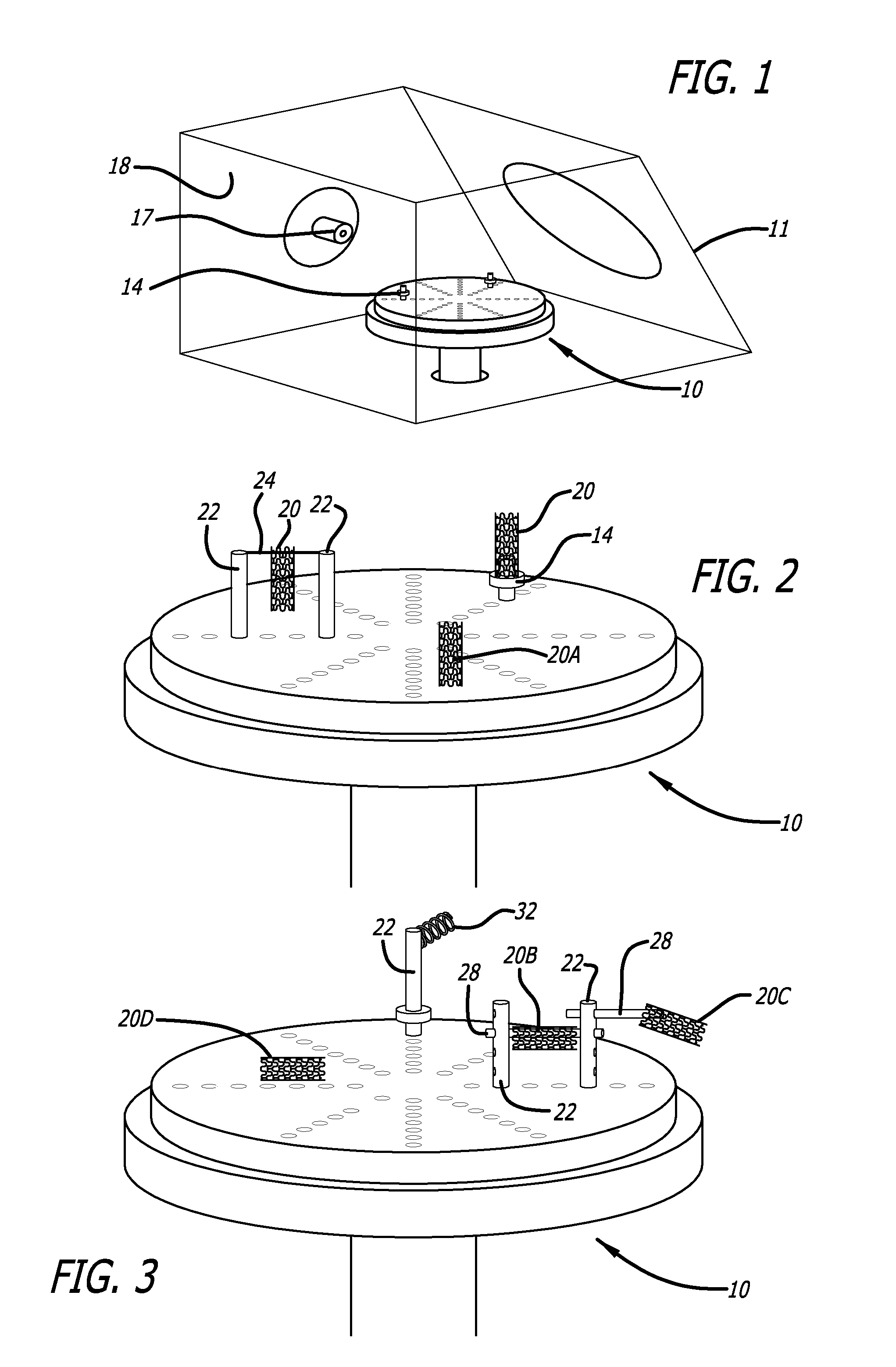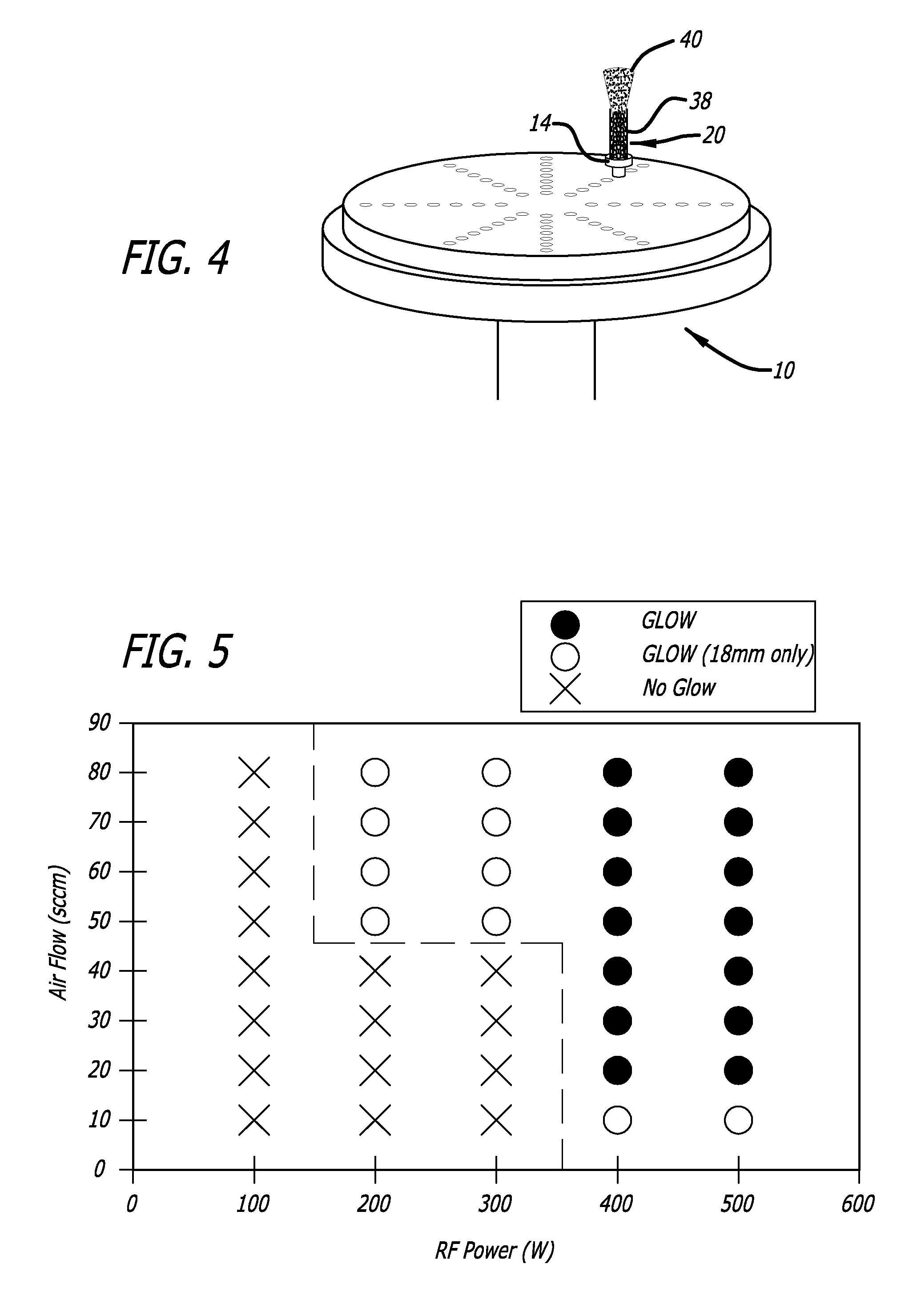Medical devices having textured surfaces
a technology of medical devices and textured surfaces, which is applied in the direction of prosthesis, internal osteosynthesis, elbow joints, etc., can solve the problems of drug's immediate release, loss of efficacy or serious injury, and reduced beneficial effects of drugs, so as to reduce atmospheric pressure
- Summary
- Abstract
- Description
- Claims
- Application Information
AI Technical Summary
Benefits of technology
Problems solved by technology
Method used
Image
Examples
example 1
Surface Texturing of Metal Wires
[0129]Metal wires (5 cm length, 300 μm diameter) were placed on vertical stainless steel rods and fastened to suspend the wire horizontally. The stainless steel chamber was sealed and a vacuum applied to decrease the atmospheric pressure to about 10−6 Torr. A flow of argon gas, 30 Standard Cubic Centimeters per Minute (sccm), was then applied from the inlet nozzle resulting in a process pressure of about 41 mtorr. Power (500 watts) from the RF power supply was activated and an argon plasma and RF field effect were generated. The metallic medical devices surface was heated to about 1000° C., without the application of an additional external heat source (the additional heating means in this example is provided by RF field effect), and texturing of metal wires continued for 10 minutes. After 10 minutes had elapsed, the flow of argon gas was ceased and the RF power supply shut down. The metal wires were allowed to cool to ambient temperature before remova...
example 2
Surface Texturing of Electrodes
[0130]Metal leads (platinum-iridium nail shaped electrode, 5 mm length, 500 μm diameter) were screwed in a vertical stainless steel rod. The stainless steel chamber was sealed and a vacuum applied to decrease the atmospheric pressure to about 10−6 Torr. A flow of argon gas (50 sccm) was then applied from the inlet nozzle resulting in a process pressure of about 67 mTorr. Power (500 watts) for the RF power supply was activated and argon plasma and RF field effect are generated. The metal leads were exposed to the argon plasma for 10 minutes as texturing of metal electrodes by the argon plasma continued. After 10 minutes had elapsed, the flow of argon gas was ceased and the RF power supply shut down. The metal electrodes were allowed to cool to ambient temperature before removal from the stainless steel chamber. As depicted in FIG. 8D, a Group 2 (rose) morphology was obtained on the surface of the Pt—Ir electrode.
example 3
Surface Texturing of Metal Alloy Dowel
[0131]A Ti-6Al-4V metal alloy tubular dowel (13 mm length, 3 mm diameter) was suspended with a MP35N wire (250 μm diameter) from about one third of the length of the dowel. The wires were then placed on the vertical stainless steel rods and fastened. The stainless steel chamber was sealed and a vacuum applied to decrease the atmospheric pressure to about 10−6 Torr. A flow of argon gas (50 sccm) was then applied from the inlet nozzle resulting in a process pressure of about 67 mtorr. Power (500 watts) for the RF power supply was activated and argon plasma and RF field effect are generated. The Ti-6Al-4V tubular dowel was exposed to the argon plasma for 10 minutes. After 10 minutes had elapsed, the flow of argon gas was increased from 50 sccm to 70 sccm, resulting in a process pressure of about 91 mtorr. The Ti-6Al-4V tubular dowel was then exposed to the argon plasma for 20 minutes. After time had elapsed, the flow of argon gas was ceased and the...
PUM
| Property | Measurement | Unit |
|---|---|---|
| pressure | aaaaa | aaaaa |
| pressure | aaaaa | aaaaa |
| pressure | aaaaa | aaaaa |
Abstract
Description
Claims
Application Information
 Login to View More
Login to View More - R&D
- Intellectual Property
- Life Sciences
- Materials
- Tech Scout
- Unparalleled Data Quality
- Higher Quality Content
- 60% Fewer Hallucinations
Browse by: Latest US Patents, China's latest patents, Technical Efficacy Thesaurus, Application Domain, Technology Topic, Popular Technical Reports.
© 2025 PatSnap. All rights reserved.Legal|Privacy policy|Modern Slavery Act Transparency Statement|Sitemap|About US| Contact US: help@patsnap.com



